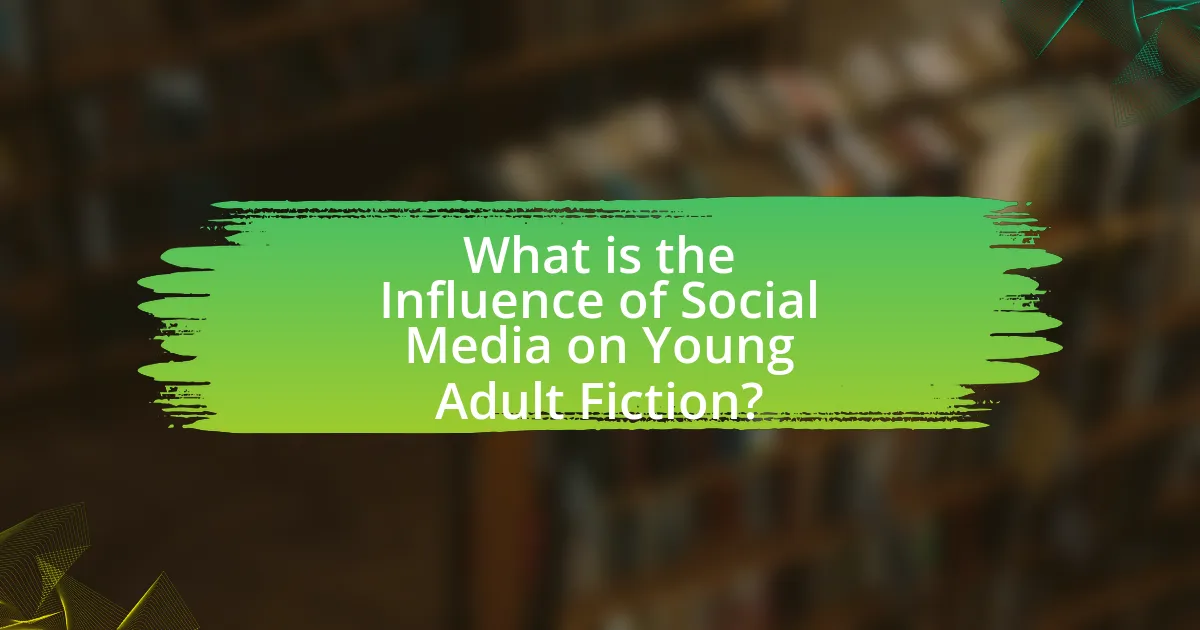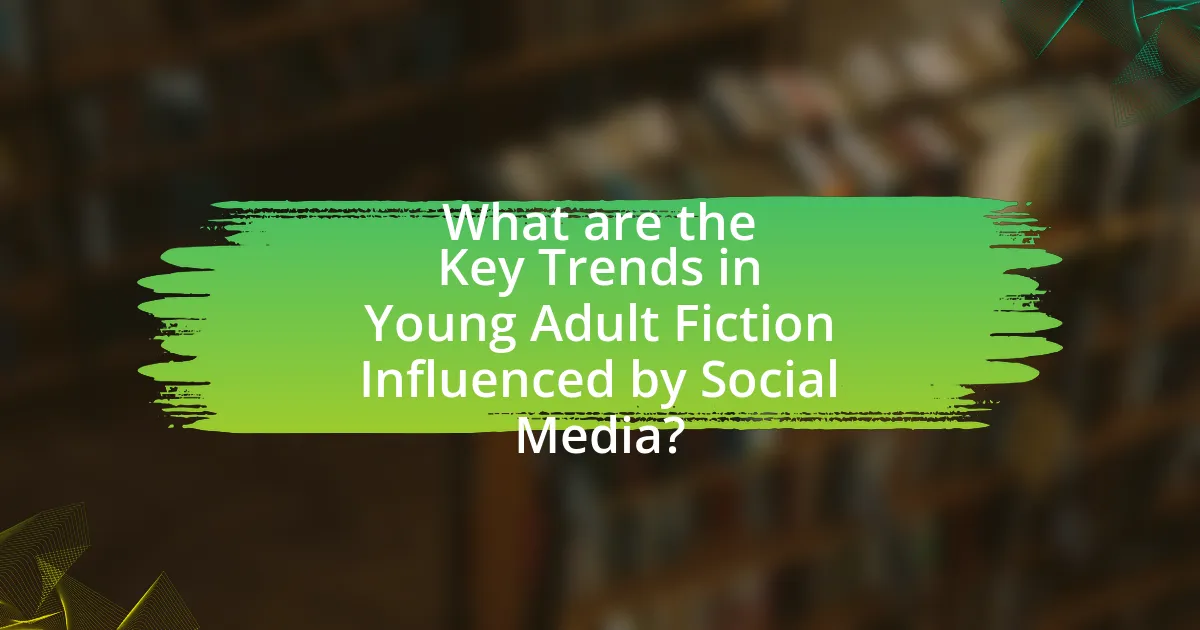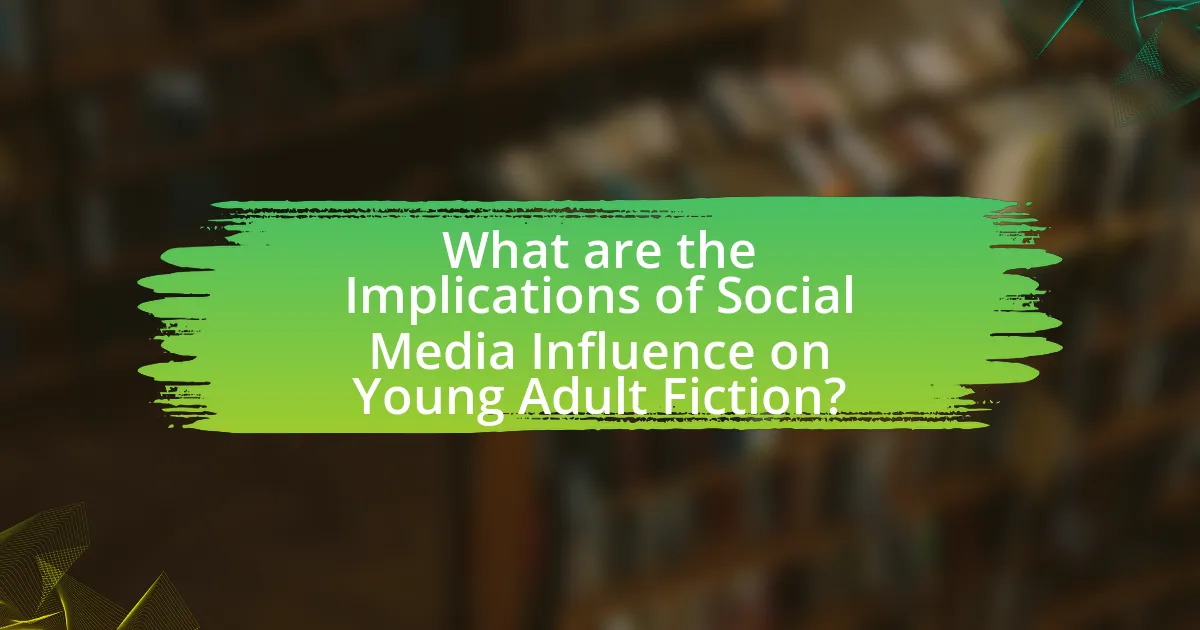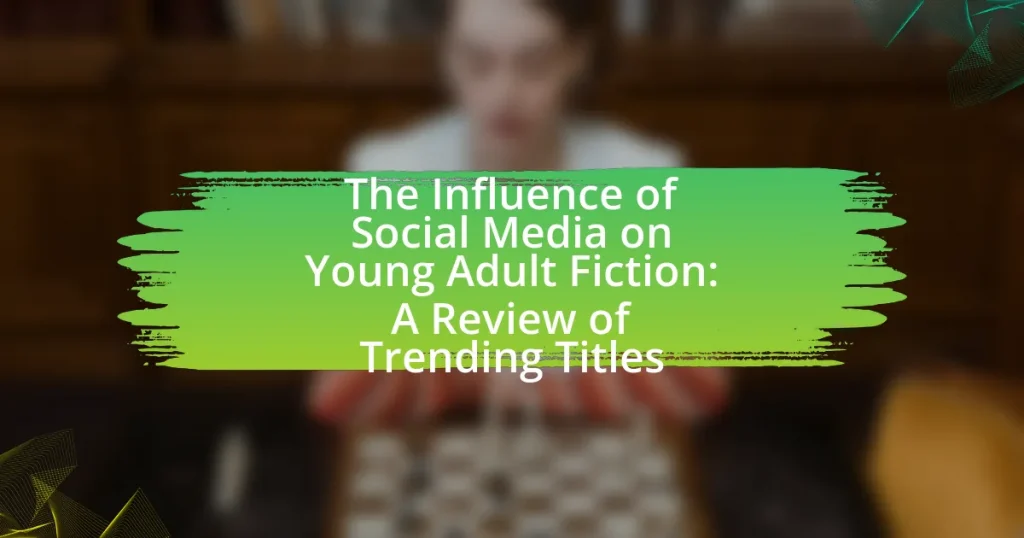The article examines the significant influence of social media on young adult fiction, highlighting how platforms like Instagram and TikTok shape trends, themes, and reader engagement. It discusses the rise of phenomena such as “BookTok,” which has propelled various titles to bestseller status, and emphasizes the direct interaction between authors and readers that fosters community and feedback. Key trends, including diverse representation and the incorporation of digital communication styles, are analyzed, along with the implications for character development and narrative styles. The article also explores the challenges authors face in integrating social media into their storytelling and offers best practices for leveraging these platforms effectively to engage with readers.

What is the Influence of Social Media on Young Adult Fiction?
Social media significantly influences young adult fiction by shaping trends, themes, and reader engagement. Platforms like Instagram and TikTok create viral trends that impact what genres and topics become popular, often leading to increased sales and visibility for specific titles. For instance, the “BookTok” phenomenon on TikTok has propelled numerous young adult novels to bestseller status, demonstrating how social media can drive reader interest and community discussions around specific books. Additionally, authors use social media to connect directly with their audience, fostering a sense of community and allowing for real-time feedback on their work, which can influence future writing. This dynamic interaction between social media and young adult fiction illustrates the evolving landscape of literature in the digital age.
How has social media changed the landscape of young adult fiction?
Social media has significantly transformed the landscape of young adult fiction by enabling direct interaction between authors and readers, fostering community engagement, and influencing publishing trends. Platforms like Instagram and TikTok allow authors to promote their work, share writing processes, and connect with fans, which enhances visibility and readership. For instance, the rise of BookTok on TikTok has led to increased sales for titles like “It Ends with Us” by Colleen Hoover, demonstrating how social media can drive book popularity. Additionally, social media facilitates the emergence of diverse voices and stories, as marginalized authors gain platforms to share their narratives, thus broadening the scope of young adult fiction.
What role do social media platforms play in promoting young adult titles?
Social media platforms play a crucial role in promoting young adult titles by facilitating direct engagement between authors, publishers, and readers. These platforms enable targeted marketing strategies, allowing publishers to reach specific demographics, particularly young adults who are active users. For instance, platforms like Instagram and TikTok have become popular for book-related content, with hashtags such as #BookTok generating millions of views and driving significant sales for featured titles. According to a 2021 report by NPD Group, books promoted on social media saw a 30% increase in sales, highlighting the effectiveness of these platforms in influencing purchasing decisions among young readers.
How do authors utilize social media to connect with their audience?
Authors utilize social media to connect with their audience by engaging directly with readers through platforms like Twitter, Instagram, and Facebook. This engagement includes sharing updates about their writing process, promoting new releases, and participating in discussions about their books, which fosters a sense of community. For instance, a survey by the Pew Research Center found that 72% of teens use Instagram, making it an effective platform for authors to reach younger audiences. Additionally, authors often host live Q&A sessions or virtual book tours, allowing for real-time interaction and feedback, which enhances reader loyalty and interest in their work.
Why is understanding this influence important for readers and writers?
Understanding the influence of social media on young adult fiction is crucial for both readers and writers because it shapes narrative styles, themes, and character development. Readers benefit from this understanding as it enhances their engagement with contemporary issues reflected in the stories, while writers can tailor their work to resonate with current trends and audience expectations. For instance, a study by the Pew Research Center indicates that 95% of teens have access to a smartphone, highlighting the pervasive role of social media in their lives, which in turn influences the content and marketing strategies of young adult literature. This awareness allows writers to create relatable characters and plots that reflect the realities of their audience, ultimately fostering a deeper connection between the text and its readers.
What insights can be gained from analyzing trending titles?
Analyzing trending titles provides insights into current reader preferences and cultural trends. By examining the themes, genres, and styles of popular titles, one can identify what resonates with audiences, such as the rise of diverse characters or specific narrative structures. For instance, data from the American Library Association indicates that young adult fiction featuring strong female protagonists has seen a significant increase in popularity, reflecting broader societal movements towards gender equality. Additionally, trending titles often highlight the impact of social media on storytelling, as many narratives incorporate digital communication, which appeals to the tech-savvy young adult demographic. This analysis can inform authors and publishers about market demands and guide future content creation.
How does social media shape reader expectations and preferences?
Social media shapes reader expectations and preferences by creating a platform for immediate feedback and community engagement, which influences the types of content that gain popularity. Readers often expect timely updates, interactive storytelling, and relatable characters, driven by trends and discussions on platforms like Twitter, Instagram, and TikTok. For instance, the rise of the “BookTok” phenomenon has led to increased visibility for specific titles, resulting in a surge in sales and reader interest, as seen with books like “It Ends with Us” by Colleen Hoover, which gained significant traction through user-generated content. This interaction not only informs readers about trending genres and themes but also fosters a sense of belonging and validation in their reading choices, ultimately shaping their preferences and expectations for future literature.

What are the Key Trends in Young Adult Fiction Influenced by Social Media?
Key trends in young adult fiction influenced by social media include the rise of diverse representation, the incorporation of digital communication styles, and the popularity of serialized storytelling. Diverse representation has become essential, reflecting the varied identities and experiences of young readers, as evidenced by the success of titles like “The Hate U Give” by Angie Thomas, which addresses racial issues and social justice. Digital communication styles, such as text messages and social media posts, are increasingly integrated into narratives, making stories relatable and contemporary, as seen in “To All the Boys I’ve Loved Before” by Jenny Han. Additionally, serialized storytelling, often popularized through platforms like Wattpad, allows for ongoing engagement with readers, exemplified by works that evolve based on reader feedback and interaction. These trends demonstrate how social media shapes the themes, formats, and accessibility of young adult fiction.
What genres are currently trending in young adult fiction?
Currently, the trending genres in young adult fiction include fantasy, contemporary romance, and dystopian fiction. These genres have gained popularity due to their ability to resonate with the experiences and emotions of young readers, often reflecting societal issues and personal growth. For instance, fantasy novels often incorporate elements of escapism and adventure, while contemporary romance addresses real-life relationships and challenges faced by adolescents. Dystopian fiction continues to engage readers by exploring themes of survival and resistance in oppressive societies, which are particularly relevant in today’s world.
How do social media trends impact genre popularity?
Social media trends significantly impact genre popularity by shaping audience preferences and driving engagement with specific genres. Platforms like TikTok and Instagram create viral trends that highlight particular genres, such as young adult fiction, leading to increased visibility and sales. For instance, the “BookTok” phenomenon on TikTok has propelled titles like “It Ends with Us” by Colleen Hoover to bestseller status, demonstrating how social media can directly influence reading habits and genre interest. This trend is supported by data showing that books trending on social media often see a spike in sales, indicating a clear correlation between social media visibility and genre popularity.
What themes are prevalent in trending young adult titles?
Prevalent themes in trending young adult titles include identity exploration, mental health, social justice, and the impact of technology. These themes resonate with the experiences of contemporary youth, reflecting their struggles and aspirations. For instance, identity exploration often manifests through characters navigating their sexual orientation or cultural backgrounds, while mental health themes address issues like anxiety and depression, which are increasingly relevant among adolescents. Social justice narratives highlight activism and awareness around issues such as racism and climate change, aligning with the values of today’s youth. Additionally, the influence of technology is depicted through characters’ interactions with social media, illustrating both its positive and negative effects on relationships and self-image. These themes are supported by recent surveys indicating that young readers are drawn to stories that mirror their realities and challenges.
How do social media challenges and movements affect storytelling?
Social media challenges and movements significantly reshape storytelling by amplifying diverse voices and narratives. These platforms enable rapid dissemination of stories that reflect social issues, allowing marginalized perspectives to gain visibility. For instance, movements like #MeToo and #BlackLivesMatter have inspired numerous narratives in young adult fiction, leading to increased representation and authenticity in storytelling. Research indicates that stories emerging from these movements resonate more with audiences, as they often address contemporary societal concerns, thus enhancing engagement and relatability.
What examples illustrate the impact of social media movements on narratives?
Social media movements significantly impact narratives by shaping public discourse and influencing storytelling in various media. For instance, the #MeToo movement has transformed narratives around sexual harassment and assault, leading to a surge in literature that addresses these themes, such as “The Hate U Give” by Angie Thomas, which explores systemic racism and personal trauma. Additionally, the Black Lives Matter movement has prompted authors to incorporate social justice themes into their works, as seen in “Dear Martin” by Nic Stone, which tackles racial profiling and identity. These examples demonstrate how social media movements not only raise awareness but also inspire authors to reflect contemporary issues in their narratives, thereby altering the landscape of young adult fiction.
How do authors respond to social issues highlighted on social media?
Authors respond to social issues highlighted on social media by incorporating these themes into their narratives, thereby reflecting contemporary societal concerns. For instance, many young adult fiction authors address topics such as mental health, racial inequality, and LGBTQ+ rights, which are frequently discussed on platforms like Twitter and Instagram. This engagement not only resonates with their audience but also fosters a dialogue around these critical issues. A notable example is Angie Thomas’s “The Hate U Give,” which tackles police brutality and systemic racism, inspired by real-life events that gained traction on social media. Such works demonstrate how authors leverage social media discourse to inform their storytelling and connect with readers on pressing social matters.

What are the Implications of Social Media Influence on Young Adult Fiction?
Social media influence significantly shapes young adult fiction by altering narrative styles, character development, and marketing strategies. The rise of platforms like Instagram and TikTok has led to a demand for relatable, diverse characters and storylines that resonate with the experiences of young readers. For instance, the popularity of the hashtag #BookTok has propelled numerous titles to bestseller status, demonstrating how social media can directly impact book sales and readership. Additionally, authors often engage with their audience through social media, fostering a sense of community and feedback that influences their writing. This interaction not only enhances reader investment but also encourages authors to address contemporary issues, reflecting the values and concerns of the younger generation.
How does social media influence character development in young adult fiction?
Social media significantly influences character development in young adult fiction by shaping characters’ identities, relationships, and conflicts. Characters often reflect the complexities of online interactions, showcasing how social media can enhance or complicate their personal growth. For instance, platforms like Instagram and Twitter serve as tools for characters to express themselves, navigate peer pressure, and confront issues such as cyberbullying or mental health, which are prevalent in contemporary society. Research indicates that young adults are heavily influenced by social media, with studies showing that 90% of teens use social media, impacting their self-esteem and social dynamics. This integration of social media into character arcs allows authors to create relatable and relevant narratives that resonate with the experiences of their audience.
What characteristics are commonly found in protagonists shaped by social media?
Protagonists shaped by social media commonly exhibit characteristics such as heightened self-awareness, a strong desire for validation, and a tendency towards performative behavior. These traits arise from the constant feedback loop of likes, comments, and shares that social media platforms create, influencing how individuals perceive themselves and their interactions with others. Research indicates that young adults often curate their online personas to gain social approval, leading to an increased focus on image and reputation. For instance, a study published in the journal “Cyberpsychology, Behavior, and Social Networking” found that social media use correlates with self-esteem fluctuations, highlighting the impact of online interactions on personal identity.
How do social media interactions affect character relationships?
Social media interactions significantly influence character relationships by facilitating communication and shaping perceptions among characters. For instance, characters can develop deeper connections through direct messaging, sharing personal experiences, or engaging in public discussions, which can lead to misunderstandings or conflicts based on misinterpretations of online behavior. Research indicates that 70% of young adults report that social media impacts their friendships, highlighting its role in relationship dynamics. Additionally, the portrayal of social media in young adult fiction often reflects real-life scenarios, where characters navigate the complexities of online interactions, thus mirroring the challenges faced by actual adolescents in their social lives.
What challenges do authors face when integrating social media into their narratives?
Authors face several challenges when integrating social media into their narratives, primarily including authenticity, pacing, and audience engagement. Authenticity is crucial, as authors must ensure that the portrayal of social media interactions feels genuine and resonates with readers, particularly in young adult fiction where relatability is key. Pacing becomes a challenge because the fast-paced nature of social media can disrupt narrative flow, making it difficult for authors to balance traditional storytelling with the rapid exchanges typical of online platforms. Additionally, audience engagement poses a challenge; authors must navigate the expectations of readers who are accustomed to interactive and multimedia experiences, which can complicate the narrative structure. These challenges highlight the need for authors to skillfully blend traditional storytelling techniques with the dynamic elements of social media to create compelling narratives.
How can authors balance authenticity with social media trends?
Authors can balance authenticity with social media trends by integrating genuine personal experiences into their narratives while strategically engaging with popular themes and formats. This approach allows authors to maintain their unique voice and perspective, which resonates with readers, while also appealing to the broader audience drawn in by current trends. For instance, a study by the Pew Research Center indicates that 71% of teens use social media, highlighting its significant influence on their interests and preferences. By aligning authentic storytelling with trending topics, authors can effectively capture the attention of young adult readers without compromising their integrity.
What pitfalls should writers avoid when referencing social media in their work?
Writers should avoid the pitfalls of over-reliance on social media trends, misrepresentation of online interactions, and neglecting the diversity of social media platforms when referencing social media in their work. Over-reliance can lead to a lack of depth in character development, as characters may become one-dimensional if solely defined by their social media presence. Misrepresentation occurs when writers fail to accurately portray the nuances of online interactions, which can result in unrealistic dialogue or scenarios. Additionally, neglecting the diversity of social media platforms can alienate readers who may not be familiar with specific platforms, limiting the relatability and accessibility of the narrative. These pitfalls can detract from the authenticity and engagement of the story, ultimately impacting its reception among young adult audiences.
What best practices can authors follow to leverage social media effectively?
Authors can leverage social media effectively by engaging consistently with their audience, sharing valuable content, and utilizing analytics to refine their strategies. Consistent engagement fosters a community around their work, while sharing valuable content, such as writing tips or insights into their creative process, establishes authority and builds trust. Utilizing analytics allows authors to understand what content resonates with their audience, enabling them to tailor their posts for maximum impact. According to a study by the Pew Research Center, 69% of adults use social media, highlighting its potential reach for authors to connect with readers.
How can authors build a strong online presence to promote their work?
Authors can build a strong online presence to promote their work by actively engaging on social media platforms, creating a professional website, and utilizing email marketing. Engaging on platforms like Instagram, Twitter, and TikTok allows authors to connect with their audience, share updates, and participate in relevant conversations, which is crucial given that 73% of marketers believe that their efforts through social media marketing have been “somewhat effective” or “very effective” for their business (Buffer, 2021). A professional website serves as a central hub for an author’s portfolio, blog, and contact information, enhancing credibility and discoverability. Additionally, email marketing enables authors to directly reach their readers with newsletters, updates, and promotions, fostering a loyal community. These strategies collectively enhance visibility and engagement, essential for promoting work in the competitive landscape of young adult fiction.
What strategies can be employed to engage with readers on social media?
To engage with readers on social media, authors and publishers can utilize interactive content, such as polls and quizzes, to foster participation. This strategy encourages readers to share their opinions and preferences, creating a sense of community. For instance, a study by the Pew Research Center found that 69% of adults use social media, indicating a vast audience for interactive engagement. Additionally, authors can host live Q&A sessions, allowing readers to ask questions directly, which enhances personal connection and investment in the content. Engaging visuals, such as book trailers or infographics, can also capture attention and stimulate discussion, as posts with images receive 94% more views than those without, according to a study by HubSpot.






